Discover the essential facts about Data Science and Big Data Analytics. Explore the relationship between these fields, their applications, and the key insights you need to know. Stay informed and unlock the potential of Data Science and Big Data Analytics in today’s data-driven world.
What Is Data Science?
Data science refers to the multidisciplinary field that combines elements of statistics, mathematics, computer science, and domain knowledge to extract valuable insights and knowledge from data. It involves various processes, including data collection, cleaning, integration, analysis, visualization, and interpretation. Data scientists use a combination of statistical techniques, machine learning algorithms, and data mining methods to uncover patterns, trends, and relationships within the data. They then use these insights to make predictions, optimize processes, and drive informed decision-making.
What Is Big Data Analytics
Big data analytics, as the name suggests, focuses on the analysis of large and complex datasets, often referred to as big data. Big data typically encompasses data that is characterized by the 3Vs: volume (large amount of data), velocity (high data generation and processing speed), and variety (diverse data types and sources). Big data analytics involves capturing, storing, processing, and analyzing these vast datasets to discover hidden patterns, correlations, and insights that traditional data analysis techniques may overlook. It often requires specialized tools and technologies to handle the volume and complexity of the data.
Key Differences: While data science and big data analytics are related, there are some key differences between the two:
- Scope: Data science is a broader field that encompasses various techniques and approaches to extract insights from data, whereas big data analytics specifically focuses on analyzing large and complex datasets.
- Data Size: Data science deals with data of all sizes, ranging from small to large, while big data analytics specifically deals with large-scale datasets that cannot be easily managed using traditional data processing techniques.
- Techniques: Data science utilizes a wide range of statistical and machine learning techniques, including regression analysis, classification, clustering, and predictive modeling. Big data analytics often relies on distributed computing frameworks, such as Apache Hadoop or Apache Spark, to process and analyze large volumes of data efficiently.
Applications of Data Science?
Business Analytics: Data science is extensively used in business analytics to analyze customer behavior, market trends, and sales patterns. It helps organizations make data-driven decisions, optimize processes, identify new market opportunities, and improve overall business performance.
Healthcare: Data science plays a crucial role in healthcare by analyzing large volumes of patient data to improve diagnostics, predict disease outbreaks, identify effective treatment plans, and personalize patient care. It also aids in drug discovery and genomics research.
Finance: Data science is widely employed in the finance industry for risk assessment, fraud detection, algorithmic trading, and portfolio management. It helps financial institutions make informed investment decisions, detect anomalies, and mitigate risks.
E-commerce and Retail: Data science drives recommendations, personalized marketing, demand forecasting, and inventory optimization in e-commerce and retail sectors. It enables businesses to understand customer preferences, improve sales, and provide a tailored shopping experience.
Social Media and Marketing: Data science techniques are applied to analyze social media data, user behavior, and sentiment analysis. It helps companies understand customer sentiments, target specific demographics, optimize marketing campaigns, and measure their effectiveness.
Transportation and Logistics: Data science is utilized in transportation and logistics to optimize routes, manage supply chains, and improve operational efficiency. It helps companies reduce costs, enhance delivery processes, and improve customer satisfaction.
Energy and Utilities: Data science is employed to analyze energy consumption patterns, optimize power generation and distribution, and predict equipment failures. It aids in energy management, grid optimization, and the development of renewable energy sources.
Telecommunications: Data science helps telecommunication companies analyze call data records, network logs, and customer behavior to improve network performance, detect anomalies, prevent fraud, and enhance customer experience.
Manufacturing and Supply Chain: Data science is used to optimize production processes, predict equipment failures, and streamline supply chain operations. It helps in inventory management, quality control, and demand forecasting.
Government and Public Policy: Data science is increasingly used in government and public policy domains to analyze data for better decision-making, policy formulation, resource allocation, and predictive modeling for public health and safety.
Areas of Applications of Big Data
Big Data Financial Services
Credit card companies, retail banks, private wealth management advisories, insurance firms, venture funds, and institutional investment banks all leverage big data in their financial services. These entities face a common challenge of dealing with vast amounts of multi-structured data residing in disparate systems, and big data offers a solution. The application of big data in financial services encompasses several areas, such as:
- Customer analytics
- Compliance analytics
- Fraud analytics
- Operational analytics
Big Data in Communications:
Telecommunication service providers prioritize gaining new subscribers, retaining customers, and expanding within their existing subscriber bases. Addressing these challenges necessitates the ability to combine and analyze the massive volumes of customer-generated data and machine-generated data produced daily in the telecommunications industry.
Big Data in Retail
In the retail sector, whether it’s a brick-and-mortar company or an online retailer, the key to staying competitive lies in understanding customers better. Achieving this requires the capability to analyze diverse data sources that companies encounter on a daily basis. This includes weblogs, customer transaction data, social media data, store-branded credit card data, and data from loyalty programs. By leveraging big data analytics, retailers can gain insights that inform their strategies and help them provide a more personalized and engaging customer experience.
Applications of Data Analytics
Data Analytics in Healthcare:
Hospitals face the challenge of efficiently treating a large number of patients while maintaining high standards of care. To address this, instrument and machine data are increasingly utilized to monitor and optimize patient flow, treatment processes, and equipment usage. Leveraging data analytics software from analytics companies, it is projected that a one percent efficiency gain could lead to over $63 billion in global healthcare savings.
Data Analytics in Travel Adventure:
Data analytics plays a crucial role in enhancing the buying experience by analyzing mobile/weblog and social media data. Travel websites can gain insights into customer preferences, allowing them to offer customized packages and upsell products based on correlated sales and browsing patterns. Social media data-driven analytics also enable personalized travel recommendations.
Data Analytics in Gaming:
Data analytics contributes to the collection and optimization of data within and across games. Gaming companies can gain valuable insights into user preferences, enabling them to tailor their offerings and improve user experiences.
Data Analytics in Energy Management:
Data analytics is extensively used in energy management, encompassing smart-grid management, energy optimization, energy distribution, and building automation in utility companies. The focus here lies in controlling and monitoring network devices, dispatching crews, and managing service outages. By integrating millions of data points and leveraging analytics, utilities can effectively monitor network performance and ensure efficient operations.
What Does a Data Scientist, Big Data Professional and Data Analyst Do?
To gain a comprehensive understanding of the distinction between data science and data analytics, let’s delve into the roles and responsibilities associated with each occupation.
Data Scientists: Data scientists collaborate closely with business stakeholders to comprehend their objectives and determine how data can be utilized to achieve those goals. They are accountable for data cleaning and organization, data set collection, mining data for patterns, refining algorithms, integrating and storing data, and constructing training sets. Data scientists apply their expertise in statistical analysis and machine learning to extract insights and develop predictive models.
Big Data Professionals (Analytics Professionals): The term “Big Data” has evolved, and professionals in this field are now recognized more as analytics professionals. They engage in reviewing, analyzing, and reporting on the massive amounts of data maintained by the organization. They identify challenges related to Big Data, devise solutions, employ statistical techniques, enhance data quality for reporting and analysis, and manipulate the data to derive valuable insights.
Data Analysts: Data analysts are responsible for collecting, cleaning, and studying data sets to transform them into actionable resources that aid in problem-solving and goal attainment within the organization. They perform data exploration, visualization, and basic statistical analysis to derive meaningful conclusions and make informed recommendations.
While there is some overlap among these roles, it largely depends on the specific structure and processes within each business. In certain companies, data scientists may assume multiple responsibilities and wear different hats to cater to the organization’s needs. The nature of the positions can blur the distinctions, but the core responsibilities outlined above help differentiate their primary functions.
- YOU MAY ALSO READ>>> Artificial intelligence (AI) And Machine Learning (ML) : Facts you must know
Skills Required to Become a Data Scientist
Education: The majority, 88 percent, of professionals in this field hold master’s degrees, while 46 percent have obtained PhDs.
Proficiency in SAS or R: In-depth knowledge of either SAS or R is highly valued in the field of data science, with R being particularly preferred.
Python programming: Data science predominantly relies on Python as the primary coding language. Additionally, familiarity with Java, Perl, and C/C++ can be advantageous.
Hadoop platform: While not always mandatory, having knowledge of the Hadoop platform is often preferred in the field. It is also beneficial to possess some experience with Hive or Pig.
SQL database and coding: Despite the rise of NoSQL and Hadoop, expertise in writing and executing complex queries in SQL is still preferred in many data science roles.
Handling unstructured data: Data scientists should be adept at working with unstructured data, whether it involves social media content, video feeds, or audio. Proficiency in extracting insights from unstructured data is crucial in this field.
Skills Required to Become a Big Data Specialist
Analytical skills: Possessing strong analytical skills is crucial for effectively interpreting and determining the relevance of data when creating reports and seeking solutions.
Creativity: The ability to think creatively is essential in developing innovative methods for gathering, interpreting, and analyzing data. This skill enables professionals to uncover valuable insights and devise unique data strategies.
Mathematics and statistical skills: Proficiency in mathematics and statistics is fundamental for accurate data analysis and “number crunching” in the realms of data science, data analytics, and big data.
Computer science: Knowledge of computer science is vital as computers serve as the backbone of every data strategy. Programmers are required to devise algorithms that efficiently process data, transforming it into actionable insights.
Business skills: Big data professionals need to possess business acumen and understand the underlying processes that drive business growth and profitability. Having a grasp of business objectives allows them to align data strategies with organizational goals.
Skills Required to Become a Data Analyst
Programming skills: Proficiency in programming languages like R and Python is essential for data analysts. These languages enable analysts to manipulate, process, and analyze data effectively.
Statistical skills and mathematics: Data scientists need a strong foundation in descriptive and inferential statistics, as well as a solid understanding of experimental designs. These skills are necessary for conducting rigorous data analysis and drawing accurate conclusions.
Machine learning skills: Familiarity with machine learning techniques and algorithms is crucial for data scientists. This enables them to develop predictive models, perform clustering and classification tasks, and extract valuable insights from data.
Data wrangling skills: Data analysts should possess the ability to transform raw data into a more structured format that facilitates easier analysis and interpretation. This involves cleaning, organizing, and integrating data from various sources.
Communication and data visualization skills: Effective communication skills are essential for data professionals to convey their findings and insights to stakeholders. Additionally, the ability to present data visually through charts, graphs, and dashboards enhances understanding and aids decision-making.
Data intuition: A valuable trait for data professionals is the ability to think critically and intuitively about data. This entails the capacity to identify patterns, spot anomalies, and ask meaningful questions that drive the analysis process.
Data Scientist Salary
On average, the annual salary for a Data Scientist can range from around $85,000 to $180,000 or more. Entry-level Data Scientists with less experience typically earn salaries in the lower range, while those with several years of experience and advanced skills can command higher salaries.
Big Data Specialist Salary
On average, the annual salary for a Big Data Specialist can range from around $80,000 to $150,000 or more. Entry-level specialists with limited experience may earn salaries in the lower range, while those with several years of experience and expertise in handling large datasets and implementing big data technologies can command higher salaries.
Data Analyst Salary
On average, the annual salary for a Data Analyst can range from around $50,000 to $100,000 or more. Entry-level analysts with limited experience may earn salaries in the lower range, while those with several years of experience and specialized skills can command higher salaries.
Last Word
In conclusion, understanding the key facts about Data Science and Big Data Analytics is crucial in harnessing the power of data in today’s world. Data Science involves extracting insights and knowledge from large volumes of data, while Big Data Analytics focuses on analyzing and interpreting massive datasets.
These fields are revolutionizing industries by enabling data-driven decision-making, identifying patterns, predicting trends, and optimizing business processes. With the right tools and techniques, businesses can gain valuable insights and drive innovation.
It is important to recognize the interplay between Data Science and Big Data Analytics and their respective applications. By staying informed about these fields, individuals and organizations can leverage the potential of data to gain a competitive advantage and make informed decisions.







